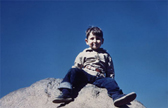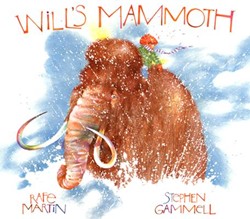|
“The Boy Who Loved Mammoths and My Writing Process,” by Rafe Martin From The Boy Who Loved Mammoths published by Yellow Moon Press
|
 |
| Young Rafe on the Mammoth Boulder |
The Boy Who Loved Mammoths, both in the original and the later, told versions, and Will’s Mammoth, the picture book which grew out of them, all themselves grew out of wishes and dreams which began when I was eight years old, growing up in New York City. My favorite place back then was a boulder in my neighborhood. When I climbed up on it—only good climbers could do it—it came alive. It was a big gray boulder and in my mind it was an elephant. In fact, my friends and I called it Elephant Rock. It was shaped like an elephant, too, with a great bulge for a head, mounded shoulders, and a slope for the hind legs and tail. In my mind I can still feel the smooth, worn stone. In dreams my fingertips can still find the those hard-won, painfully learned tiny notches, ledges, and grooves in the stone (fingers there, knee press there, shift the other hand, hang by a fingertip so), which gave me the gripping points to leverage myself successfully up. I can still remember, too, deep in my bones, the thump as I hit the ground sliding back down. (The only way to get off was to slide down the “tail.”)
That boulder had been pushed to where New York City was later to grow up around it by the glaciers during the Ice Age. And it had been left there as glacial debris for at least 20,000 years. History unfolded around it. It had been part of the culture, I think, most especially, the child culture of that area since earliest times. Perhaps the earliest Paleo-Indian peoples had felt its power. Perhaps their children, too, as well as those of later Native peoples, had climbed on it over the thousands of years going all the way back to the time when mammoths still roamed.
The adults in my neighborhood never knew that this was Elephant Rock— not unless, of course, some child kindly gave them its proper name and told them about it.
Years later, when my children were growing up, I went back to my old neighborhood and discovered, on an early morning walk, that my boulder had been bulldozed away. That doorway into the imagination, into the dreaming of that specific place on the earth and to all that had happened there, into the life of natural things, my own life as a child, was closed. I felt real loss and sadness and I realized, too, that natural places, dreaming places, all around the earth are threatened daily. As we destroy them, we destroy the gateways to our own deepest potential for thinking, dreaming, imagining. I realized the only way I could pass this particular doorway on, pass on the experience of faith in the power of the dreaming, imagining mind which that boulder had given me, would now be through a story. That’s where the story I’ve titled The Boy Who Loved Mammoths and later, Will’s Mammoth, began. As a child I had often wished that I could see a live mammoth. So in the story, Elephant Rock of my childhood became the mammoth of Will’s. I named the boy “Will,” by the way, because he has the determination, the “will,” to make his dreams real. Also two of my favorite authors were William Blake and William Shakespeare.
In stories wishes can come true. This is in part what makes them so important. Things that might not, could not happen in ordinary reality do happen in stories. Stories allow us to explore, experience, and make real deep archetypes of wish and dream—universal patterns of challenge and fulfillment. The ending of The Boy Who Loved Mammoths with those hairs or of the picture book Will’s Mammoth with the flower, are moments in which we all can remember the power of our own dreaming and imagining. “In dreams begin responsibilities,” said the poet W. B. Yeats. So too all things we create in life begin with what we dream. The imagination, a realm of endless possibility, is the real foundation of our lives and accomplishments.
In our culture we tend to discount this great power. So I’d like to mention something interesting that happened when I had finished writing The Boy Who Loved Mammoths more than ten years ago. In the original story Will is saved by a mammoth who stands over him keeping him safe through the storm. Well, one night I was in the car across the street from a local bookstore where my wife was buying a book. I was just sitting there watching the snow whirl down and I was listening to National Public Radio’s evening broadcast. They were talking about a little boy who had wandered out of his house—it was in Wisconsin, I think—or Minnesota, someplace rural and cold. There was a bad storm. Search parties were out. They were sure that when they found the boy he’d be frozen and dead. A large puppy about nine months old from the boy’s house was also missing—a big, shaggy puppy. They found the boy near dawn. He was lying on the snow, his shoes and socks off—but he wasn’t frozen, not even frost-bitten. With him was that large, shaggy puppy. It had remained standing over him the whole night keeping him warm. In my mind I heard the Twilight Zone theme-music—do do do do do do do do—I watched the snow falling past the windshield, brightly lit against the street lights. And I thought. “So it’s true. I just wrote that story. I didn’t know if it could really happen. But it can. It did.”
Not long after I also discovered that Inuit peoples have tales about mammoths. They say that a great shaman drove all the mammoths underground long ago. That’s why their bones and sometimes their frozen carcasses are found in the earth—as if they were coming back up to the surface. These legends also say that one night each year mammoths can return to live on the earth. So Will’s Mammoth and The Boy Who Loved Mammoths actually have a history going back much further than my own personal wishes and dreams.
Sharing this story or these versions of this story (as storytellers quickly learn there are many ways of telling any given story), is a way of sharing my faith in the importance of our essential human powers of wish and of dream—something every child knows. It’s a way of saying that the imagination and its formal structures, stories, offer us a great gift—the restoration of our own Vision.
I’ve come to realize that I’m essentially a dreamer, like Will. I’ve been talking about Will’s Mammoth, a dream of mine, and how it developed from the wishes and memories of my childhood in many keynote addresses and workshops across the country for years. I touched on it a bit too in my book, A Storyteller’s Story. It’s a relief to have the original version out as a book now so both adults and children can see what the changes have actually been. And it’s been interesting too in communicating all this to realize just how deeply the dreams of our childhoods can inform our lives— our real, creative lives—as adults.
Good luck in your own dreaming, in your own writing and storytelling.


 Though many people know my picture book for young readers Will’s Mammoth, not many know how that story actually began. Those who have heard me tell the original story have been amazed to discover that it’s actually a complex tale suitable for older children and even adults, not a story necessarily for young children at all. And they ask, why did I change it to make it a picture book? And would I someday do a story book (one with few illustrations and lots of words) of the original version, the way I originally wrote it, the version my telling is actually based upon? Over the years these requests have piled up on my desk. So with The Boy Who Loved Mammoths, I’ve at last brought out the story as I originally wrote it—with some terrific illustrations by my friend Richard Wehrman. (You can also hear the way I tell this story on the audiocassette Rafe Martin tells his Children’s Books.) Here s the afterword to the book in which I talk about my writing process—Will’s Mammoth—the picture book so wonderfully illustrated by Caldecott winner Stephen Gammell—is almost wordless. I decided when working on it that in the picture book we could be inside the child’s imagination. Seeing what he sees. The beauty of a picture book is that it’s very much like storytelling. Listening to a story told, we don’t see words in our minds but pictures. As I worked on the picture book version I began to see images in a key, to use a musical analogy, most appropriate for young readers. When work on the book began I wrote out for Stephen Gammell everything I was seeing in all the silent places of the story and then let him show us, in his wonderful images, what Will imagines. At the end of the picture book Will is asleep, yet he holds in his hand the flower given him by the mammoth in his daydream. And the flower is Real!
Though many people know my picture book for young readers Will’s Mammoth, not many know how that story actually began. Those who have heard me tell the original story have been amazed to discover that it’s actually a complex tale suitable for older children and even adults, not a story necessarily for young children at all. And they ask, why did I change it to make it a picture book? And would I someday do a story book (one with few illustrations and lots of words) of the original version, the way I originally wrote it, the version my telling is actually based upon? Over the years these requests have piled up on my desk. So with The Boy Who Loved Mammoths, I’ve at last brought out the story as I originally wrote it—with some terrific illustrations by my friend Richard Wehrman. (You can also hear the way I tell this story on the audiocassette Rafe Martin tells his Children’s Books.) Here s the afterword to the book in which I talk about my writing process—Will’s Mammoth—the picture book so wonderfully illustrated by Caldecott winner Stephen Gammell—is almost wordless. I decided when working on it that in the picture book we could be inside the child’s imagination. Seeing what he sees. The beauty of a picture book is that it’s very much like storytelling. Listening to a story told, we don’t see words in our minds but pictures. As I worked on the picture book version I began to see images in a key, to use a musical analogy, most appropriate for young readers. When work on the book began I wrote out for Stephen Gammell everything I was seeing in all the silent places of the story and then let him show us, in his wonderful images, what Will imagines. At the end of the picture book Will is asleep, yet he holds in his hand the flower given him by the mammoth in his daydream. And the flower is Real! 